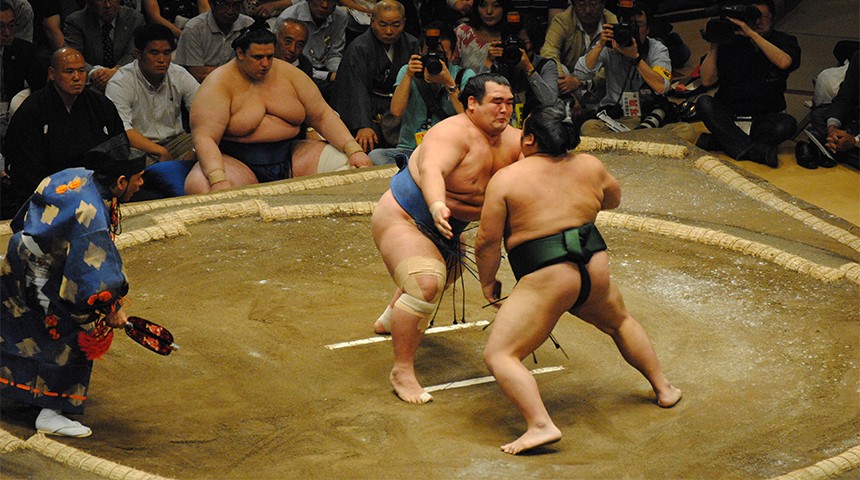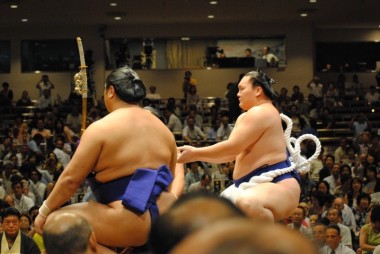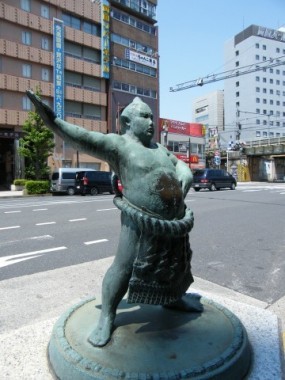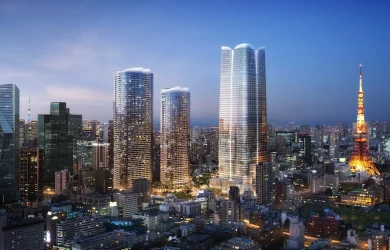
Sumo returns to Tokyo’s Ryogoku Kokugikan May 14th–28th, and with an even more earth-shattering development than usual. For the first time in 14 years, fans will be able to witness a homegrown grand champion plying his trade.
Thirty-year-old Kisenosato Yutaka finally ascended to sumo’s highest rank in January this year, after claiming his maiden top-division championship. In doing so, he became the first Japanese to be promoted to sumo’s yokozuna apex since 1998, and will become the first grand champion to grace a Tokyo ring since Takanohana in January 2003.
The rules of sumo are refreshingly simple: the first wrestler to touch down inside the ring, or step out of it, is the loser. Most bouts are over in a matter of seconds, but some thrilling encounters may last several minutes. The force with which two 150-kilogram behemoths collide is genuinely frightening, and truly incredible power is needed to withstand an opponent’s charge, drive him backwards and throw him to the ground.
Yokozuna status is the highest honor in sumo. Since the sport turned professional in the 1760s, only 73 men have ever attained the rank. No clear promotion criteria are defined, but the general consensus is that a wrestler on the second rank of ozeki must either win two tournaments in a row, or win 27 bouts out of 30 to get there. Once at the summit, the yokozuna is not only expected to give an excellent account of himself, but to bear responsibility for the public standing of the entire sumo association. Should he ever commit the cardinal sin of losing more matches than he wins in a tournament, he must tender his resignation immediately.

Kisenosato’s 188-cm, 180-kg frame certainly embodies a force to be reckoned with. At present, he is the youngest of the current yokozuna and seemingly at the zenith of his powers. His courageous fight-back on the final day of the March tournament in Osaka, when he overcame injury to defeat gargantuan Mongolian Terunofuji twice in 30 minutes, captured the hearts of the nation. The pressure to restore domestic pride in Japan’s national sport remains tremendous, but Kisenosato at last looks capable of rising to the challenge.
The protracted birth of a home-grown grand champion is the by-product of an unprecedented period of foreign domination in sumo. Since the Mongolian wrestler Asashoryu embarked upon his record-breaking 11 tourney wins out of 12 in January 2004, only six of the ensuing 79 tournaments have been won by Japanese. The current grand champion, Hakuho Sho, also from Mongolia, has captured a jaw-dropping 37 of the championships—a sumo record. Although subdued by the effects of injury these days, his speed of thought remains undiminished, and he will doubtless exhibit breathtaking flashes of skill as he chases down retired ozeki Kaio’s all-time record of 1047 career wins.
Hakuho and Kisenosato will be joined on the top rank by two more Mongolians, Harumafuji and Kakuryu, each of whom is capable of producing trophy-winning form. Indeed, fans will be treated to the rare spectacle of four yokozuna ring-entering ceremonies per day, each of which sees a grand champion don a magnificent white copper-cord belt and thunderously stamp his feet on the dohyo to drive away evil spirits.
There are, of course, several other wrestlers worthy of attention. Terunofuji, presently on the second rank, stands 193 centimeters tall, weighs a massive 190 kilograms, and would likely be a yokozuna by now were it not for an untimely knee injury. He has already taken home the coveted Emperor’s Cup once, and—as the last tournament indicated—could be unstoppable if the stars align in his favor. His fellow second-ranker, Goeido, has also won a tournament championship and is something of a technical magician. He will be fighting desperately to retain his rank after withdrawing from the March tournament due to injury. Anxious to either join him there or replace him will be Takayasu, Kisenosato’s younger stablemate, oft-touted as Japan’s next great hope. For sheer showmanship, however, look no further than Ura, the smallest wrestler in the top two divisions at just 173 centimetres and 113 kilograms, renowned for dazzling his foes with a series of leaps, bounds and devastating throws.

However, a day at the sumo is about so much more than just the fighting. It is about the awesome sight of the kimono-clad wrestlers entering the arena, the sounds of the claves and the referee’s kabuki-style wailing; and the smells of beer, bento boxes and bintzuke—the overpowering liniment oil used to lacquer the wrestlers’ hair. You can find numerous souvenirs inside the arena, ranging from wrestler-themed key rings and rice crackers to grand champion handprints and the woodblock impressions of top sumo artist Daimon Kinoshita. Intriguing sumo memorabilia can also be witnessed in both the sumo museum and the resplendent entrance hall trophy cabinet. You can even sample one of sumo’s signature chanko nabe stew recipes for a bargain ¥300 in the Kokugikan basement between 12pm and 2pm each day.
Food lovers will be pleased to learn that the area surrounding Ryogoku is awash with sumo-themed restaurants, many of which are owned by ex-wrestlers keen to monetize their trusted chanko recipes. Arguably top of the pile is Chanko Yoshiba, located a seven-minute walk from the Kokugikan on the opposite side of the picturesque Yasuda Memorial Garden. Another popular hangout is Chanko Kirishima, to be found next to the McDonald’s on Kokugikan Street. It is managed by a former top-division champion named Kirishima Kazuhiro, who makes a point of greeting each of his customers on a match day.
Outside the restaurant stands one of several sumo statues lining the main road, underneath which several bronze handprints of sumo greats can be found. The line of statues terminates at the T-junction of Kokugikan Street and Keio Street, behind which stands the imposing red gate of the famous Eko-in. The grounds of this Buddhist temple also host the towering Sumo Stone of Strength, erected in 1936 to celebrate the survival of the sumo association in highly adverse economic and social conditions.
In short, prepare yourselves for another action-packed fortnight along the banks of the Sumida River.





